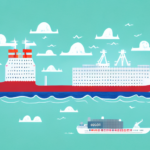Understanding UPS Sea Shipping Rates
For businesses engaged in international trade, selecting a reliable carrier with competitive rates is crucial. UPS stands out as a prominent shipping company favored by many businesses for its comprehensive services and global reach. This guide delves into the intricacies of UPS sea shipping rates, examining the advantages of using UPS for maritime logistics, the factors influencing their pricing, comparisons with other carriers, strategies for securing better rates, and real-world examples of cost savings.
The Benefits of Using UPS for Sea Shipping
UPS offers a multitude of advantages for sea shipping that can significantly benefit businesses. One of the primary benefits is cost-effectiveness, particularly for large-scale international shipments. According to [UPS’s 2023 Annual Report](https://www.shipscience.com/annual-report-2023), businesses that frequently ship large volumes overseas can take advantage of bulk pricing, which reduces overall shipping costs.
Reliability is another key benefit. UPS provides real-time tracking, allowing businesses to monitor their shipments closely. This transparency ensures that companies can manage their supply chains more effectively and respond promptly to any logistical issues.
Customization options further enhance UPS’s appeal. Businesses can select from various shipping options, including 3PL services, which offer integrated logistics solutions tailored to specific business needs.
UPS is also committed to sustainability. The company has implemented eco-friendly initiatives such as utilizing alternative fuels and optimizing shipping routes to minimize carbon emissions. These efforts resonate with environmentally conscious businesses aiming to reduce their carbon footprint.
With a global network of partners and facilities, UPS ensures seamless shipping solutions to almost any destination. This extensive network means that whether shipping to a major port or a remote location, UPS has the resources and expertise to ensure timely and secure delivery.
How Sea Shipping Rates are Determined by UPS
UPS sea shipping rates are influenced by several factors, including the distance between the origin and destination, the weight and dimensions of the shipment, and the nature of the cargo. For instance, heavy or oversized shipments will incur higher rates due to the increased space and handling requirements.
Additional factors affecting UPS sea shipping rates include customs fees, taxes, tariffs, and the necessary documentation. These costs can vary significantly depending on the countries involved and the type of goods being shipped. According to [The International Trade Administration](https://www.trade.gov), understanding these variables is essential for accurate cost estimation.
UPS also considers the mode of transportation used within the sea shipping process. Specialized containers or equipment may be required for certain types of cargo, leading to higher rates. Seasonality plays a role as well; peak shipping seasons, such as the holiday period, often see increased rates due to higher demand.
Service type is another determinant of shipping rates. Express services, which guarantee faster delivery times, generally cost more than standard services. Businesses must weigh the urgency of their shipments against budgetary constraints to choose the most appropriate service level.
Comparing UPS Sea Shipping Rates to Other Carriers
When evaluating sea shipping options, it's beneficial to compare UPS rates with those of other shipping carriers like FedEx, DHL, and USPS. While UPS often offers competitive pricing, rates can vary based on factors such as shipment origin, destination, weight, and size.
Transit time is a critical consideration alongside cost. Some carriers may offer faster delivery options for specific routes, which can be pivotal for time-sensitive shipments. Businesses must assess whether the cost savings of slower transit times are acceptable within their operational frameworks.
Customer service quality also varies among carriers. UPS is renowned for its excellent customer support, which can be a decisive factor for businesses that prioritize reliable service. Reviewing customer feedback and service ratings can provide insights into each carrier's reliability and support effectiveness.
Tips for Negotiating Better UPS Sea Shipping Rates
Negotiating better rates with UPS involves several strategic approaches. Bundling services is an effective method; for example, consolidating multiple shipments to a single destination can result in volume discounts. Businesses that maintain consistent shipping patterns may find it advantageous to negotiate long-term contracts that offer reduced rates.
Volume-based negotiations can also lead to significant savings. The more a business ships, the more leverage it has to negotiate lower rates. Establishing a strong shipping history with UPS can facilitate better pricing terms over time.
Working with a logistics provider can simplify the negotiation process. These providers possess expertise in international shipping and can negotiate on behalf of businesses to secure favorable rates and terms.
Flexibility in shipping schedules can also lower costs. By being open to adjusting delivery dates, businesses can take advantage of off-peak rates, which are typically lower than peak season rates.
Understanding all applicable fees, such as fuel surcharges, customs fees, and handling charges, is crucial. Negotiating these fees upfront can prevent unexpected costs and ensure that businesses stay within their budgetary constraints.
Understanding the Different Types of UPS Sea Shipping Services
UPS provides a variety of sea shipping services to accommodate different business needs. These include express services for expedited deliveries, standard services for cost-effective shipping, and 3PL services that offer comprehensive logistics solutions encompassing warehousing, packaging, and transportation.
UPS also offers specialized services tailored to specific industries. For example, the healthcare sector benefits from temperature-controlled shipping options, ensuring that sensitive medical products remain within required temperature ranges. Similarly, the automotive industry can leverage UPS’s specialized handling to manage and transport delicate automotive parts securely.
In addition to sea shipping, UPS provides air and ground shipping options, allowing businesses to select the most appropriate shipping method based on their specific needs, whether for speed, cost, or a balance of both. All UPS shipping services include tracking and insurance options, providing businesses with peace of mind and the ability to monitor their shipments throughout the transportation process.
A Step-by-Step Guide to Calculating Your UPS Sea Shipping Costs
Calculating UPS sea shipping costs involves several steps:
- Determine Weight and Size: Accurately measure the weight and dimensions of your shipment, as these are primary factors in cost calculation.
- Identify Origin and Destination: The distance between the shipping origin and destination significantly impacts the rate.
- Choose Service Type: Select the appropriate UPS service level (express, standard, or 3PL) based on your delivery requirements and budget.
- Obtain a Quote: Use UPS’s online tools or contact a UPS representative to get an accurate quote based on the above factors.
Additional costs may include customs clearance fees, insurance, and other surcharges. It's essential to review all components of the quote to understand the total shipping cost fully. Leveraging UPS's online calculators and consulting with UPS specialists can provide more precise estimates tailored to your specific shipping needs.
Factors That Can Impact Your UPS Sea Shipping Rates and How to Mitigate Them
Several factors can influence UPS sea shipping rates:
- Customs Fees and Tariffs: Varying by country and product type, these fees can add significant costs. Working with a knowledgeable logistics provider can help navigate these complexities and manage costs effectively.
- Shipment Weight and Size: Larger and heavier shipments naturally incur higher rates. Optimizing packaging to reduce size and weight can lead to substantial savings.
- Seasonality: High-demand periods can drive up rates. Planning shipments during off-peak times can mitigate cost increases.
- Documentation Accuracy: Ensuring all shipping documents are complete and accurate reduces the risk of delays and additional fees.
To mitigate these factors, businesses should collaborate closely with logistics experts, optimize their shipping strategies, and maintain accurate and thorough documentation. Additionally, exploring alternative shipping methods or consolidating shipments can help manage and reduce overall shipping costs.
Real-Life Examples of How Businesses Have Saved Money on UPS Sea Shipping Rates
Numerous businesses have successfully reduced their UPS sea shipping costs through strategic measures. For instance, one company negotiated lower rates by consolidating shipments, which allowed them to leverage volume discounts. By working closely with a logistics provider, they streamlined their shipping processes and achieved significant cost savings.
Another business optimized their packaging to decrease the weight and size of their shipments, resulting in lower shipping costs without compromising the integrity of their products. Additionally, some companies have taken advantage of UPS’s volume discount programs by increasing their shipping frequency, which further reduced their per-shipment costs.
Volume discounts are particularly effective; businesses that ship larger quantities can negotiate better rates with UPS. Moreover, some organizations have found that using alternative shipping methods, such as rail or trucking for specific routes, can be more cost-effective and efficient than sea shipping alone.
These examples underscore the importance of proactive shipping strategies and the benefits of collaborating with logistics professionals to identify and implement cost-saving opportunities.
In conclusion, a thorough understanding of UPS sea shipping rates and the factors influencing them is essential for optimizing shipping operations. By implementing the strategies and tips outlined in this guide, businesses can make informed decisions, negotiate better rates, and ultimately enhance their logistical efficiency and cost-effectiveness.






















